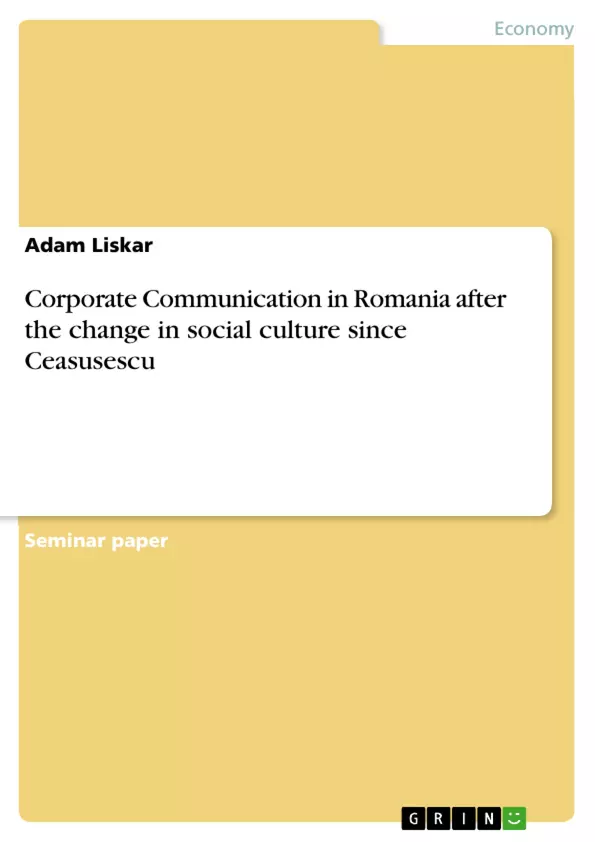Throughout history, all countries and nations of the world have probably experienced a transformation of society, norms and values through political and cultural changes. Such movements inevitably change the laws and rules, people in the country and working conditions and the economy. The companies often have more opportunities to act independently to lead more marketing, advertising and public relations on an international level and thus become economically interesting. The possible participation in the world market through imports and exports also changes the corporate and economic structures of the countries concerned. Especially in countries with extremely difficult or oppressive political circumstances, there is a high level of social and economic change after the change of government. One such country is Eastern European Romania, which today is one of the most interesting enlargement countries in the EU. (Bidder, B., 2017).
This is also confirmed by the growth figures from 2017 for the third quarter of the Central and Eastern European economy. Romania's economy grew by as much as 8 percentage points year-on-year, placing it in first place with the fastest growing economy in Europe and the highest growth in relative terms worldwide, outperforming China and India. (Bidder, B., 2017).
Inhaltsverzeichnis (Table of Contents)
- Introduction
- 1.1 Approach and aim of the work
- 2 Corporate Communications
- 3
- 3.1 Historical and cultural background
- Economic and media situation during Ceausescu
- 3.2 The Romanian social culture
- Changes after the turn in year 1989
- 4
- 4.1 Changes in society
- 4.2 Changes in economic
- 4.3 Changes in corporate structures
- 5
- 6
- 6.1 Intern
- 6.2 Extern
- 7 Media an Communication after 1989
- 8 Corporate Communication today
- Conclusion
Zielsetzung und Themenschwerpunkte (Objectives and Key Themes)
This work aims to explore the transformation of corporate communications in Romania after the fall of the communist regime. It focuses on the impact of social and cultural changes on the evolving communication landscape. The work analyzes the historical and economic context, identifies restructuring trends in companies and their communication tools, and highlights the development of internal and external corporate communication in the post-Ceausescu era.
- The impact of social and cultural changes on corporate communication in Romania.
- The historical and economic context of Romania before and after the fall of Ceausescu.
- The restructuring of companies and their communication tools.
- The development of internal and external corporate communication.
- The role of Western investors in Romania's economic growth and corporate landscape.
Zusammenfassung der Kapitel (Chapter Summaries)
- Introduction: The introduction sets the stage by discussing the broader context of societal transformations and their impact on corporate communication. It highlights the significant economic growth experienced by Romania after the change in government and emphasizes the role of Western investors in driving this expansion.
- 1.1 Approach and aim of the work: This section outlines the goals of the work, focusing on explaining the changes in corporate communications in Romania following the fall of Ceausescu. It emphasizes the importance of understanding the historical, political, and cultural background of the country to fully grasp the economic transformations and the development of corporate communication strategies.
- 2 Corporate Communications: This chapter provides a comprehensive definition of corporate communication, encompassing both internal and external communication strategies. It emphasizes the importance of corporate communication for building trust, satisfaction, and commitment within the company and with external stakeholders.
- 3 Historical and cultural background: This section delves into the historical and cultural background of Romania, highlighting the economic and media situation under Ceausescu. It then explores the profound social and cultural changes that occurred after the 1989 revolution, emphasizing their impact on Romanian society and corporate landscape.
- 4 Changes in society, economy, and corporate structures: This chapter examines the changes in Romanian society, economy, and corporate structures following the revolution. It discusses the impact of these transformations on internal and external communication channels, highlighting the emerging opportunities and challenges for companies operating in the post-communist environment.
- 6 Intern and Extern: This section explores the distinction between internal and external corporate communication, elaborating on the specific communication strategies employed for different target groups. It highlights the role of internal communication in fostering employee identification with the company, while external communication focuses on building relationships with customers, the public, and international markets.
- 7 Media and Communication after 1989: This chapter examines the role of media and communication in the post-revolution era. It analyzes the development of communication channels and technologies and discusses how companies adapted to the changing media landscape.
Schlüsselwörter (Keywords)
The main keywords and focus topics of this work include: corporate communication, Romania, post-communist transition, social and cultural changes, economic growth, Western investment, internal and external communication, media landscape, restructuring of companies, and communication strategies.
- Quote paper
- Adam Liskar (Author), 2018, Corporate Communication in Romania after the change in social culture since Ceasusescu, Munich, GRIN Verlag, https://www.grin.com/document/503751



